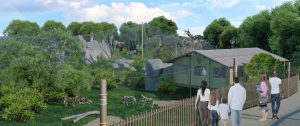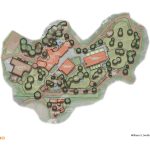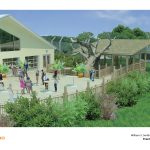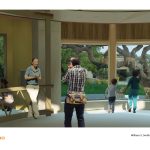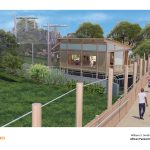67% Funded
Donate Today
- Project Timeline: Break ground in 2024
- Architects: WDM Architects
African Wilds will provide a much-needed new home for our lions, painted dogs, meerkats and other African animals. In addition, it will introduce pygmy hippos and bring back a favorite of our zoo guests, zebras!
Every guest deserves the opportunity to connect one-on-one with the animals of Africa. As the largest expansion to date in the African section of the zoo, this exhibit will encompass over 7 acres that will transport guests to an authentic backpacking trip through modern-day Africa. It replaces the outdated 1960s-era cat grottos located at the back of the zoo.
Lions may be seen sleeping on rocky outcroppings called kopjes (‘kä-pes). Meerkats will dig subterranean tunnels, while a lone sentry keeps watch for danger. Listen to African bird calls in the immersive Adelson Family Foundation Walkthrough Aviary and Vultures. Experiences will be designed for up-close viewing in the heat of summer and the cold of winter, while providing the animals in our care year-round species-specific habitats.
Multi-Species Exhibit Complex

The African Wilds exhibit complex will include new and engaging animal exhibits for guests of all ages. Children will be able to get closer than ever before to our African animals through new glass viewing, like at the Zarrow Zebra Habitat and the H.A. and Mary K. Chapman Zebra Overlook. These once-in-a-lifetime guest experiences inspire wonder and amazement in our visitors, and keep them coming back time and time again to the Tulsa Zoo.
As we continue to rebuild the zoo, we anticipate one million annual guests to experience the wonder and excitement of the new African Wilds exhibit. The ability to experience wild animals and wild places diminishes each and every day. The Tulsa Zoo and the African Wilds complex will bring this experience closer than ever, instilling respect for animals and the natural world for generations to come.
Pride of lions, pack of painted dogs, mob of meerkats, and troop of Diana monkeys. Whatever you call them, the animals of African Wilds are certain to amaze and engage guests of all ages. Seeing how similar yet different these groups are will be possible through creative design features that immerse you directly into their worlds.
African Lion Habitat
The centerpiece of the new facility will surely be the African lion habitat. No visit to the zoo is complete without spotting a pride of lions lying in the tall grass. Multiple viewing portals will ensure this experience. New state-of-the-art facilities will replace our outdated lion exhibit from the 1960s that no longer meets the standards of a modern zoo. Climate-controlled, off-exhibit spaces, indoor and outdoor habitats and other amenities will serve animals, staff and guests alike. An added feature will allow after-hours rentals in the Chapman Event Lodge to gain unique views into the lion habitat. Lions are often quite active after dark!
Pygmy Hippo & Diana Monkey Exhibit
Animals in wild places share similar habitats and home ranges. This is true for two threatened species in West Africa – pygmy hippopotamus and Diana monkeys. Both depend on forests close to rivers, streams and swamps for their homes. While Diana monkeys have a long and successful history at the Tulsa Zoo, pygmy hippos will be a brand new resident. Mixing them in a new outdoor habitat will be unique to only a handful of zoos worldwide. Of the two types of hippopotamus – common river and pygmy – pygmy hippos are much smaller in size, weighing around a fifth of their enormous cousins’ weight. They are also seen in only a dozen facilities in North America. Their aquatic needs will be met with both indoor and outdoor pools and state-of-the-art water filtration to ensure a clear view every time. The Diana monkeys will amble above their counterparts on branches, vines and trees. They will have a dedicated climate-controlled indoor exhibit to retreat to when temperatures drop, while remaining visible to our guests.
African Painted Dogs
Painted dogs are intensely social animals, living most of the time in close association with each other. While a minimum of six dogs are necessary to successfully hunt and breed, a pack can be as small as a pair, or as large as thirty. A focus on providing for their needs will be balanced by a desire to showcase their amazing adaptations, such as the trait of the painted dog to vocalize, the audible extension of the pack’s social world. Communication is vital, unique, and important to the strength of pack unity. African painted dogs are one of the most endangered carnivores in Africa, despite having up to 13 puppies in a single litter. Updated spaces for our painted dogs are needed if we wish to become a breeding center for this important species.
Guest Amenities
While our guests are focusing on the animals, the zoo will also focus on our guests. Additional restrooms, including family restroom options, and water bottle filling stations will be added. A permanent pavilion structure will be constructed at our existing tent pad site allowing for both increased seating for dining and special event rentals. Additional concession locations and a dedicated classroom for educational programming will be included nearby.
Thank you to our project partners!
William S. Smith Charitable Trust | Adelson Family Foundation | Bank of Oklahoma Financial | Betty Pirnat | Carol and Ken Lackey | City of Tulsa | Frank & Gayle Eby | Gentner and Wendy Drummond | Grace and Franklin Bernsen Foundation | H.A. and Mary K. Chapman Trust | Hannah and Joe Robson | Hardesty Family Foundation | Hille Foundation | Jim and Suzanne Kneale Family Foundation | John and Sandy Stava | Kasey and Davilyn Worthington | Leslie and Bob Pritchard | ONE Gas | ONEOK | Pepsi Co. | Rosemary Jones Charitable Fund | Stuart Family Foundation | The Anne and Henry Zarrow Foundation | The Helmerich Trust | The Mervin Bovaird Foundation | Waters Charitable Foundation



